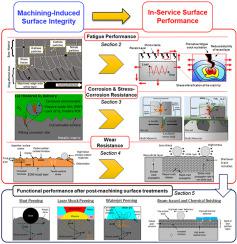International Journal of Machine Tools and Manufacture ( IF 14.0 ) Pub Date : 2021-03-16 , DOI: 10.1016/j.ijmachtools.2021.103718 Andrea la Monaca , James W. Murray , Zhirong Liao , Alistair Speidel , Jose A. Robles-Linares , Dragos A. Axinte , Mark C. Hardy , Adam T. Clare

|
Material removal operations play a pivotal role in the manufacture of key components, required for engineering systems to operate safely and efficiently under ever more advanced functional requirements and over extended life cycles. To further step up the loading capability of machined parts, fundamental understanding of how of machining-induced features can influence the performance of advanced materials under complex service conditions is necessary over finer temporal and spatial scales. As discussed in Part I of this review, when engineering surfaces are generated by material removal processes, a wide range of physical mechanisms (e.g. mechanical, thermal, chemical and their combinations) drive the characteristics of workpiece surface integrity. In Part II of this review, the interplay between the metallurgical and micro-mechanical condition induced by material removal processes and their in-service response will be thoroughly explored, by a critical analysis of the state-of-the-art in the field. Specifically, attention is focused on recent advances made towards the understanding of the mechanisms determining the resistance of machined surface to fatigue crack nucleation (Section 2), corrosion and stress-corrosion cracking (Section 3), and wear (Section 4). Furthermore, the impact of relevant post-machining treatments on the in-service behaviour of machined surfaces is analysed, and the possible strategies for the enhancement of the functional performance of machined surfaces are presented (Section 5). Finally, the current research gaps and the prospective challenges in understanding the in-service behaviour of machined surfaces are critically discussed, providing an interpretation of the possible directions of future scientific development of this field.
中文翻译:

金属加工中的表面完整性-第二部分:功能性能
材料去除操作在关键部件的制造中起着至关重要的作用,这是工程系统在越来越高级的功能要求下以及更长的使用寿命内安全有效地运行所必需的。为了进一步提高加工零件的负载能力,必须在更精细的时间和空间范围内,对在复杂的使用条件下,加工诱发的特征如何影响高级材料的性能有基本的了解。如本评论的第一部分所述,当通过材料去除过程生成工程表面时,各种各样的物理机制(例如,机械,热,化学及其组合)驱动着工件表面完整性的特征。在本评论的第二部分中,通过对该领域的最新技术进行批判性分析,将彻底探索由材料去除过程引起的冶金和微机械状态与其在役响应之间的相互作用。具体而言,注意力集中在确定机械加工表面对疲劳裂纹成核(第2节),腐蚀和应力腐蚀开裂(第3节)以及磨损(第4节)的抵抗力的机理方面。此外,分析了相关的后加工处理对机加工表面的使用行为的影响,并提出了提高机加工表面功能性能的可能策略(第5节)。最后,

























 京公网安备 11010802027423号
京公网安备 11010802027423号